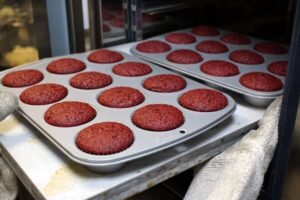Baking is a delicate science that involves the precise combination of ingredients, temperature, and techniques to create the perfect cake. Understanding the science behind baking is crucial to mastering the art of cake making. When it comes to cake dome formation, it all comes down to the interaction of ingredients and the physical processes that occur during baking. The main players in cake dome formation are the proteins, starches, and leavening agents in the batter.
During the baking process, the proteins in the flour form gluten when mixed with liquid. Gluten gives structure and strength to the cake, but too much gluten development can lead to a tough and dense cake. On the other hand, starches in the flour gelatinize and absorb liquid during baking, contributing to the cake’s texture and crumb. Leavening agents, such as baking powder and baking soda, create air bubbles in the batter, which expand during baking and help the cake rise. Understanding how these ingredients interact with each other and with heat is essential for controlling cake dome formation.
Baking is a precise science that requires attention to detail and an understanding of the chemical reactions that occur during the process. By understanding the role of ingredients, temperature, and techniques, bakers can gain insight into how to control cake dome formation and achieve the desired results in their baked goods.
Key Takeaways
- Understanding the science of baking is crucial for achieving the perfect cake dome.
- The role of ingredients, such as flour and sugar, can significantly impact cake dome formation.
- Oven temperature plays a key role in determining the shape of the cake dome.
- Leavening agents, like baking powder and baking soda, are essential for creating a desirable cake dome.
- Different mixing techniques, such as creaming and folding, can affect the formation of the cake dome.
- Tips for preventing or embracing cake dome can help bakers achieve their desired results.
- Experimenting with recipes and adjusting ingredients can help control the formation of cake dome.
The Role of Ingredients in Cake Dome Formation
The ingredients used in cake baking play a crucial role in the formation of the cake dome. Flour, sugar, eggs, fat, and leavening agents all contribute to the structure and texture of the cake, which in turn affects the formation of the dome. The type and amount of each ingredient used can have a significant impact on the final outcome of the cake.
Flour provides the structure for the cake and contributes to gluten formation when mixed with liquid. The protein content of the flour, as well as the type of flour used, can affect gluten development and ultimately impact the shape of the cake. Sugar not only sweetens the cake but also tenderizes it by interfering with gluten formation. Eggs provide moisture, structure, and stability to the batter, while fat adds richness and tenderness to the cake. Leavening agents, such as baking powder and baking soda, create air bubbles in the batter that help it rise during baking.
The combination of these ingredients, along with their proportions and interactions, can influence the formation of the cake dome. Understanding how each ingredient contributes to the overall structure and texture of the cake is essential for controlling dome formation and achieving the desired results in baking.
The Impact of Oven Temperature on Cake Dome
Oven temperature plays a critical role in cake dome formation. The temperature at which a cake is baked can affect how it rises and sets, ultimately impacting the shape of the dome. Baking at too high or too low a temperature can result in a cake with a prominent dome or a flat top.
When a cake is baked at a high temperature, the outside sets quickly, while the inside continues to rise. This rapid rise on the inside can cause the center of the cake to push upwards, resulting in a prominent dome. On the other hand, baking at a low temperature can lead to insufficient rise and a flat top.
Achieving the perfect oven temperature is crucial for controlling cake dome formation. It is important to preheat the oven to the correct temperature and to monitor the baking process closely to ensure that the cake rises evenly and sets properly. By understanding how oven temperature affects cake baking, bakers can take steps to control dome formation and achieve consistent results in their baked goods.
The Importance of Leavening Agents in Cake Baking
| Leavening Agent | Function | Effect on Cake |
|---|---|---|
| Baking Powder | Produces carbon dioxide gas when mixed with liquid and heat | Creates a light and airy texture |
| Baking Soda | Requires an acidic ingredient to activate and produce carbon dioxide gas | Helps cakes rise and become fluffy |
| Yeast | Produces carbon dioxide gas through fermentation | Creates a soft and spongy texture |
Leavening agents are essential ingredients in cake baking that play a crucial role in controlling dome formation. Baking powder and baking soda are commonly used leavening agents that create air bubbles in the batter, which expand during baking and help the cake rise. The proper use of leavening agents is essential for achieving the desired texture and shape of the cake.
Baking powder is a combination of an acid (such as cream of tartar) and a base (such as baking soda) that react when mixed with liquid and heat. This reaction produces carbon dioxide gas, which causes the batter to rise. Baking soda, on the other hand, requires an acidic ingredient (such as buttermilk or yogurt) to activate its leavening properties.
The amount of leavening agents used in a recipe can significantly impact dome formation. Too much leavening can cause the cake to rise excessively and result in a collapsed or cracked dome, while too little leavening can lead to a dense and flat cake. Understanding how leavening agents work and how to properly use them is essential for controlling dome formation and achieving consistent results in cake baking.
How Different Mixing Techniques Affect Cake Dome
The mixing technique used in cake baking can have a significant impact on dome formation. The way in which ingredients are combined and mixed can affect gluten development, air incorporation, and ultimately, the shape of the cake. Different mixing techniques can result in varying textures and structures in the final baked goods.
Overmixing can lead to excessive gluten development, which can result in a tough and dense cake with a prominent dome. On the other hand, undermixing can lead to uneven distribution of ingredients and air bubbles, which can result in an uneven rise and an irregularly shaped dome. Proper mixing techniques, such as folding or gently stirring, can help achieve a more even distribution of ingredients and air bubbles in the batter.
Understanding how different mixing techniques affect cake dome formation is essential for achieving consistent results in baking. By mastering proper mixing techniques, bakers can control dome formation and achieve the desired texture and shape in their cakes.
Tips for Preventing or Embracing Cake Dome

Controlling dome formation in cakes can be challenging, but there are several tips and techniques that bakers can use to prevent or embrace it. To prevent a prominent dome, bakers can try using cake strips or lowering the oven temperature slightly to encourage more even rise and setting. Additionally, using a lower protein flour or adding an extra egg yolk can help tenderize the cake and reduce gluten development, resulting in a more even top.
On the other hand, some bakers may want to embrace the natural dome that forms on their cakes. To enhance and emphasize the dome, bakers can use a higher protein flour or increase leavening agents to encourage more rise. Additionally, using a higher oven temperature or starting with a thicker batter can help promote dome formation.
Ultimately, whether preventing or embracing dome formation, it is important for bakers to experiment with different techniques and recipes to find what works best for their desired outcome. By understanding how different factors contribute to dome formation and by being open to experimentation, bakers can achieve consistent results in their baked goods.
Experimenting with Recipes to Control Cake Dome
Experimenting with recipes is an essential part of mastering cake baking and controlling dome formation. By adjusting ingredients, proportions, mixing techniques, and oven temperatures, bakers can gain insight into how different factors impact dome formation and how to achieve their desired results.
When experimenting with recipes to control dome formation, bakers can try using different types of flour with varying protein content to see how it affects gluten development and texture. They can also adjust the amount of leavening agents used to see how it impacts rise and shape. Additionally, experimenting with different mixing techniques and oven temperatures can provide valuable information on how to achieve consistent results in dome formation.
By keeping detailed notes on their experiments and paying close attention to how different adjustments impact their cakes, bakers can gain valuable insights into controlling dome formation. Through experimentation and observation, bakers can refine their techniques and recipes to achieve their desired texture and shape in their baked goods.
I recently came across an interesting article on the science behind why cakes dome when baking. The article delves into the factors that contribute to this common baking phenomenon and offers helpful tips for achieving a perfectly flat cake. If you’re a baking enthusiast or simply curious about the science of baking, I highly recommend checking out the article here. It’s a fascinating read that sheds light on the mysteries of cake baking!




















+ There are no comments
Add yours